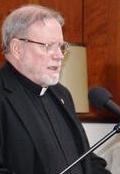by Fr. Patrick Henry Reardon
 Against many heresies — Gnosticism and Manichaeism early and chief among them — Holy Church has been obliged to advocate the inherent goodness of the material world. Her position on this point has always been based, not only on the biblical doctrine of Creation —
Against many heresies — Gnosticism and Manichaeism early and chief among them — Holy Church has been obliged to advocate the inherent goodness of the material world. Her position on this point has always been based, not only on the biblical doctrine of Creation —
“God saw everything that He had made, and indeed it was very good”
— but also on the conviction that the goodness of created matter was vindicated in a definitive way by the Resurrection of Christ. Every tendency to doubt that goodness has been shouted down, as it were, by the same objection:
“Handle Me and see, for a spirit does not have flesh and bones as you see I have.”
As a matter of fact, the Resurrection is a fact of matter: the Lord’s risen body is a real body, made up of chemical components. Although endowed with new spiritual qualities, such as the ability to pass through locked doors, His risen body loses nothing of its material nature. It is not so “spiritual” as to be intangible:
“Reach your finger here, and inspect My hands; and stretch out your hand and put it into My side.”
Holy Church has remained ever sensitive on this point, regarding with stern disfavor any hint of a discontinuity between the body created and the body raised. They are the identical body:
“It is sown in dishonor, it is raised in glory. It is sown in weakness, it is raised in power. It is sown a natural body, it is raised a spiritual body.”
What is buried and what is raised are numerically one, and in any suggestion to the contrary the Church recognizes a false cosmology.
 In fact, false cosmologies, and dualistic cosmologies in particular, seem ever to threaten the foundations of the Christian faith. The Alexandrian catechist, Origen, who imagined the body to be the material prison of the preexistent soul, taught an example of this error.
In fact, false cosmologies, and dualistic cosmologies in particular, seem ever to threaten the foundations of the Christian faith. The Alexandrian catechist, Origen, who imagined the body to be the material prison of the preexistent soul, taught an example of this error.
To sustain his thesis, Origen was obliged to treat the Resurrection as an allegory of spiritual restoration.
The sainted bishop Methodius of Olympus, martyred in 311, recognized heresy here. Against Origen he wrote:
“I will not endure certain chatterers [phlenaphonton tinon] that do violence to Scripture, in order to find support for their opinion that the resurrection is without flesh — they allegorize ‘mental bones’ [osta noeta] and flesh” (On the Resurrection 39).
Origen’s error, according to Methodius, was cosmological: Origen believed that the union of the body with the preexistent soul was unnatural, because the soul possessed an integrity of its own. Consequently, the separation of the soul from the body — by death — was a restoration of the soul’s integrity.
Methodius perceived that such a teaching meant the very end of the Christian faith, because it removed all soteriological value from the Resurrection. For him, the human “difference” wrought by Christ was the abolition, not of matter, but of mortality. An orthodox Christian cosmology requires that salvation be attained, not by the separation of body and soul, but by the conferral of immortality and incorruptibility on the whole man, body and soul.
Why, then, the prior dissolution of death? To answer this question, Methodius compared God to a sculptor, who sees His beloved handiwork spoiled and disfigured by an enemy:
“Seeing man, His fairest work, corrupted by envious treachery, He could not endure, with His love for man, to leave him in such a condition, lest he should be for ever defective, and bear the blame for eternity; but He dissolved him again into his original components, so that, by remodeling, all the blemishes in him might waste away and disappear. For the melting down of the statue in the former case corresponds to the death and dissolution of the body in the latter, and the remolding of the material in the former, to the resurrection after death in the latter” (op. cit. 43).
Christ died, that is, in order to be raised again. He suffered the dissolution of death for the sake of man’s attaining immortality.
Such was Paul’s answer, in First Corinthians 15, to those who denied the Resurrection:
“If there is no resurrection of the dead, then Christ is not risen. And if Christ is not risen, then our preaching is empty and your faith is also empty.”
The bodily Resurrection of Christ is the cause, model, and medium of our integrity, immortality, and incorruption. It is the pledge and work of the Holy Spirit, who abides in our very flesh. St. Gregory Palamas, a thousand years after Methodius, wrote,
“the body will be indwelt and moved by the supernatural power of the divine Spirit in the age to come” (Sermon on John the Baptist 5).
